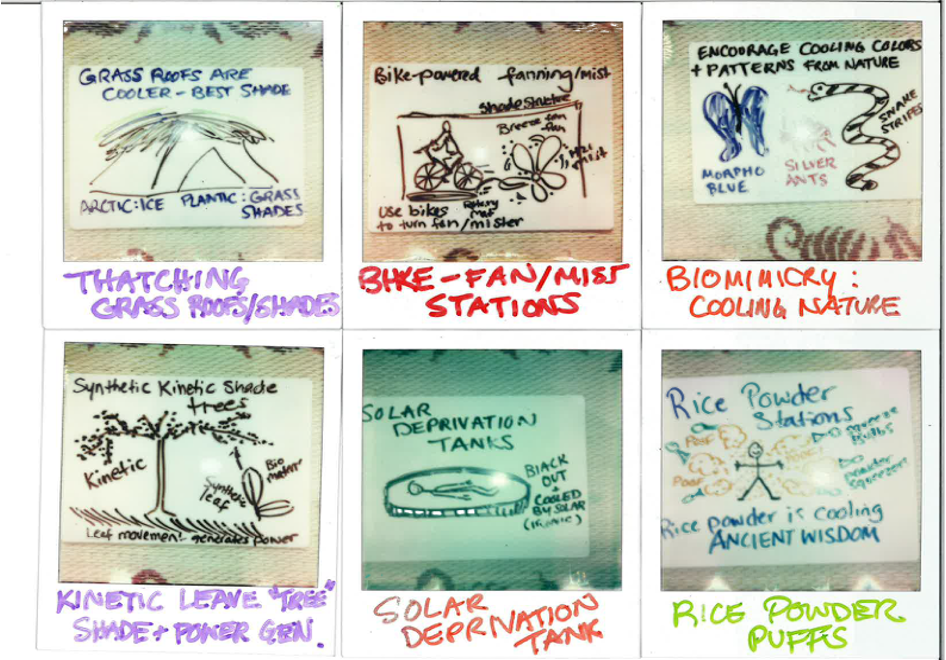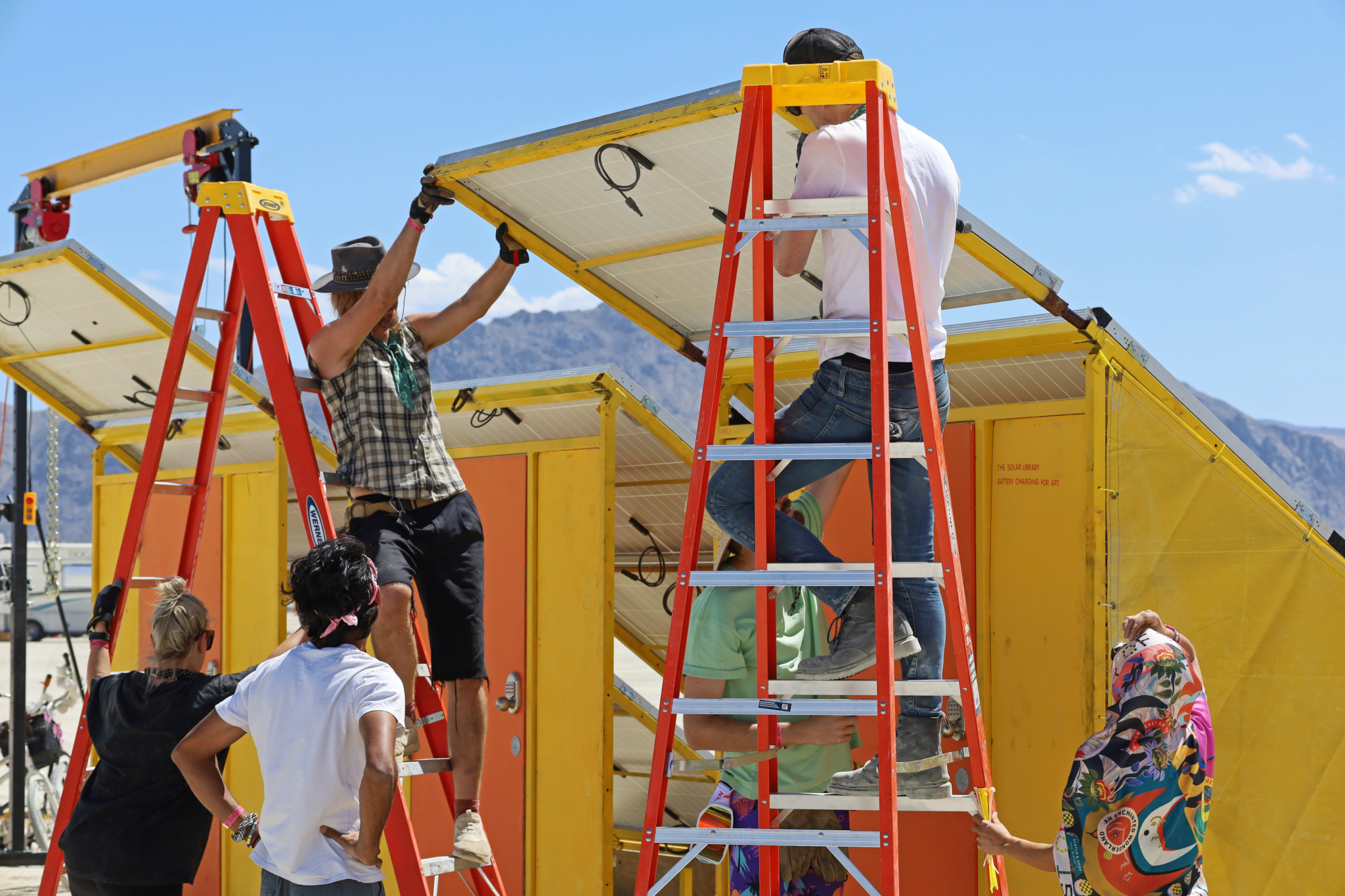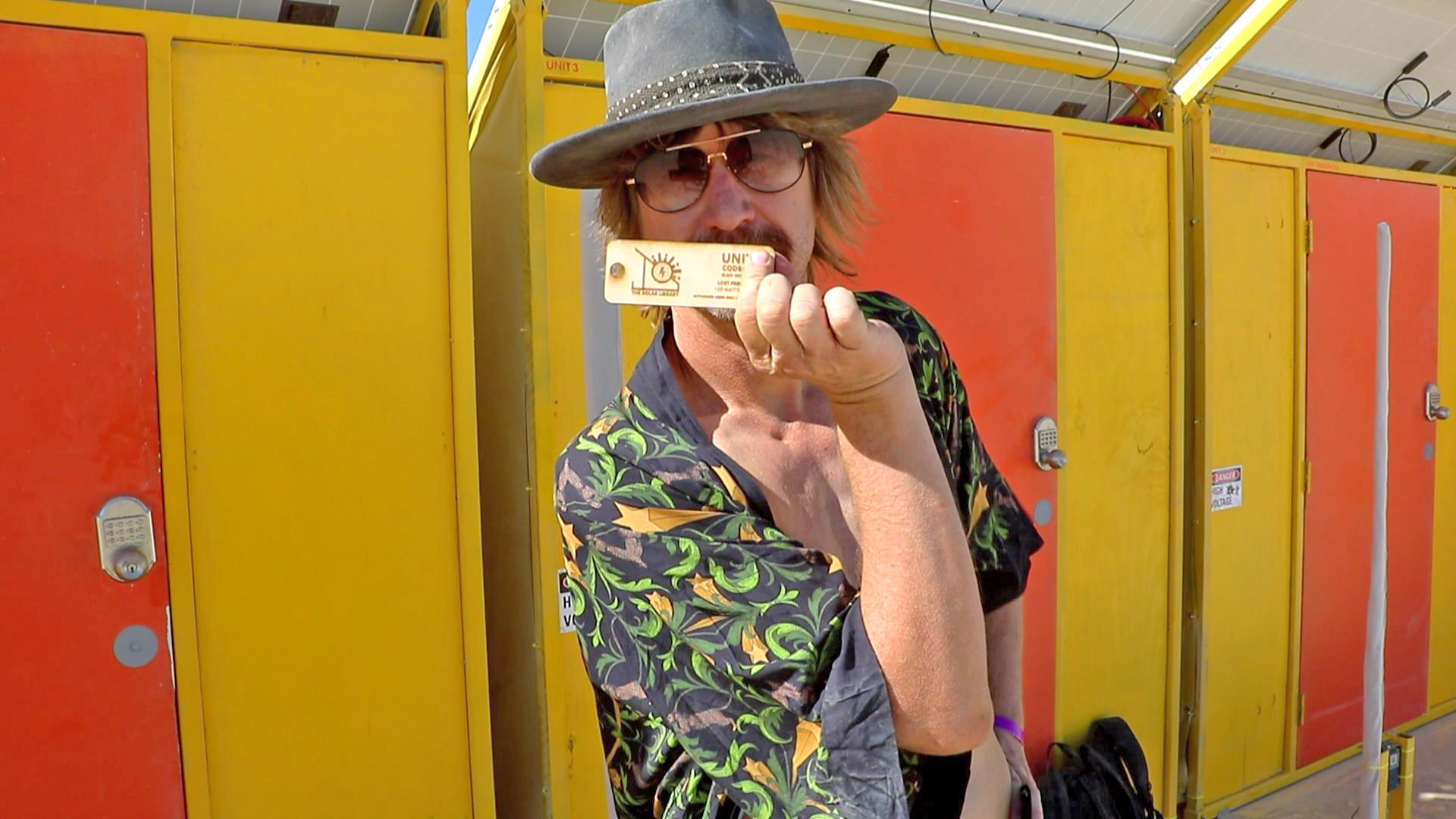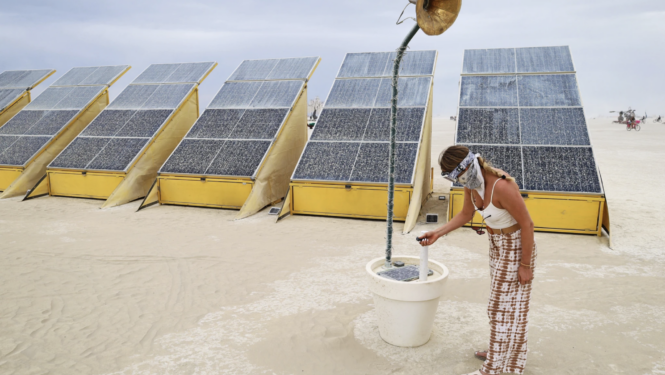If a Future Worlds’ Fair was held tomorrow, wouldn’t it look a lot like Black Rock City?
The 2025 Burning Man theme is Tomorrow Today, a reimagined future conjured in a dusty, chaotic, radically participatory laboratory. Black Rock City is a playground, yes, but it’s also a research site for the development of living systems for human survival and thrival like nowhere else.
Burning Man in Black Rock City offers a stress-test setting in one of the most extreme environments on Earth — and perhaps more importantly, an innovative population that loves to experiment. In the crucible of the Black Rock Desert, imagining a more sustainable future merges with building it, and the lessons learned can — and do — reach far beyond the playa.
Through Black Rock City Honoraria grants, innovation in event operations, and collaboration with community groups, Burning Man Project provides logistical and financial support to innovators who are developing creative solutions to the challenges humanity is facing.
Tomorrow Today will show off the same kind of technological progress and marvels as the World’s Fairs of old. From the city’s radically reimagined power grid to new modes of creative support for art, these experiments show how Black Rock City is an unparalleled proving ground for ideas that matter for humanity. Below, meet three such projects, all spearheaded by Burners bringing new spectacles of innovation to the desert.
Crowdsourcing Survival in a Hotter World

Innovation in Black Rock City starts with future-focused thinking; some researchers see in this ephemeral city a location perfectly adapted to the challenge of hacking behavior for surviving climate change. Sarah DaVanzo, futurist and innovator, recognized at her first Burn that the playa held the “perfect conditions for innovation.” With its resource scarcity, extreme setting, and creative energy, it’s an ideal Petri dish for solving the world’s most wicked problems. And, DaVanzo noted, it’s populated by innovators. “Their curiosity muscles are on overdrive!”
Sarah wanted to see what this community could dream up. In 2024, she partnered with Burning Man Project’s Regeneration team to create a work-a-thon: The Cool & Curious Sustainability Sprints, a series of “playshops” designed to crowdsource solutions for cooling sustainably in hot environments. Cool & Curious workshops sparked fun, sensory experiences, giving participants stimuli for learning and innovating around three key areas: ancient indigenous wisdom, biomimicry from nature, and futurist technology. These stimuli were designed to spark imaginations and elicit new human cooling concepts to explore.

The resulting ideas were captured and gamified on a 50′-long “Coolopoly” gameboard, where participants could play with and optimize concepts to spark invention and collaborative problem solving. DaVanzo and crew guided game play, hoping to draw conclusions about best ideas from how people played along. Ideas ranged from the practical — drinking hot beverages and high-ceilinged shade from ancient Middle Eastern cultures — to the sublime, such as bike-thru cooling station “‘poofers’” with rice powder (a natural coolant), and biokinetic digital trees with solar leaves that help provide shelter.
Sarah calls Burning Man “Learning Man,” an ideas incubator where the most valuable insights come from doing. In 2025, the experiment’s top ideas will be returned to Burning Man Project’s Regeneration team for further exploration and evolution, filtered through the imaginations of Burners.
Hacking the Metabolism of a Metropolis

Heat, dust, and unpredictable conditions make Black Rock City a perfect trial-by-fire setting for testing and iteration. According to Sean Kathleen ‘Hotspot’ Curran, Utilities Superintendent for the city’s Department of Public Works (DPW), it’s this unpredictable, chaotic setting that makes Black Rock City a hotbed of experimentation. Constant adaptation to the desert’s changing conditions makes rapid, large-scale innovation not only possible, but inevitable. “The desert is an active participant,” Hotspot explains. “One of the biggest challenges in technological innovation is finding a test environment that truly pushes products to their limits.”
For years, the challenge of powering the core infrastructure of a temporary city of 80,000 people required planning, engineering… and a lot of educated guesswork. The city infrastructure’s needs are inconsistent; they ebb and flow in the extreme Northern Nevada climate. Previously, this would lead to the use of oversized generators always generating full power, even when less power is needed at the moment.
This was a problem of scale and information, and it was environmentally unfriendly. The Mesh Net project solved this problem. Spearheaded in 2016 and 2017 by DPW’s Andrea ‘Genie’ Gini and Eric ‘le Wrench’ Peralta, the project would ultimately support possibly the largest temporary battery deployment in human history, and a system for reducing consumption and emissions that can be modeled in other settings.
The Mesh Net team created a custom setup of digital sensors to measure the energy load. Then working with Sunbelt, Black Rock City’s power vendor, they deployed battery configurations that stored unused electricity, reducing reliance on full-load fuel generators. Batteries store energy from the generator while it operates at peak fuel economy. Once fully charged, the generator shuts off, and the battery provides on-demand power to the grid. This can lead to saving hundreds of gallons of diesel on a single grid.
“In Black Rock City, we have a population that embraces challenges (and) is not risk averse in operations and infrastructure solutions,” says Hotspot. Sunbelt’s Sustainability and Innovations Manager, Ryan Crampton, observed that his team ”packed in a year’s worth of jobsite experience in six weeks.” The impact of this experiment extends beyond Nevada — it has the potential to serve others in remote or disaster settings, and even permanent networks. The same system, proven resilient on the playa, has already been deployed in disaster relief zones for hurricanes, at wildfire encampments and even the Super Bowl. There is a clear line from research and development within Black Rock City to a global solution.
Powering Art Collaboratively, with Solar

While DPW tackles the city’s energy metabolism for human needs, another, more decentralized innovation is transforming the creative setting for artists. For years, creators wanting to power artwork on the open playa faced a difficult choice: use a fuel generator, or become a solar engineer and build an aesthetically-displeasing, oversized “panel farm” next to their masterpiece. Jared ‘Pearlsnaps’ Ficklin, a product designer and artist, saw a third way.
His Black Rock City 2025 Honoraria art project, “The Solar Library,” now in year three, is a work of art in itself: a series of tall, yellow, triangular structures that serve as a centralized charging station for battery-powered art. The concept is elegantly simple: “Artists apply for a library card…and we provide dedicated charging infrastructure so that they can charge their batteries with solar power.”
The project is a masterful exercise in balancing Burning Man’s 10 Principles. It provides vital infrastructure (Communal Effort) while requiring artists to take ownership of their power needs (Radical Self-reliance) but still contribute ‘sweat equity’ by hauling batteries back and forth (Participation). The project operates as a collaborative guild built on shared values, prioritizing participation over pure efficiency.

Pearlsnaps calls it “a fusion power for art.” The impact is tangible. This year, the project expects to remove 22 generators from the playa, eliminating two tons of direct fumes and an estimated 10 gallons of potential spillage and waste. The indirect savings are even larger; by centralizing the solar infrastructure, the project saves an estimated 40 tons of CO2 from the extra vehicle trips artists would need to transport their own panel setups.
The Solar Library offers a powerful lesson for the world beyond Burning Man, which may be too focused on individual solutions when centralized ideas can have a bigger impact. The project is now building a “battery borrow” program, creating a fleet of reusable batteries so artists don’t have to purchase one for a single-use project. It’s a quiet revolution in resource sharing, showing that sometimes the most sustainable solution is the one we build together.
A Future Built with Dust, Heart and Hand
From the city-wide power grid to the individual artist and the collective brainstorm, a common thread emerges: through a mix of necessity and radical possibility, Burners are rolling up their sleeves to solve current and future challenges. They’re innovating in Black Rock City, and bringing inspired ideas to life in their home communities around the world.
Working in collaboration with this endlessly inventive community, Burning Man Project nurtures the spark that empowers people to imagine the future in new ways, and to make it real through collective actions. Burning Man, in Black Rock City and beyond is nothing short of a living, ever-evolving Future Worlds’ Fair. But rather than static displays, participants are innovating in real time, making the city itself and its citizens blueprints for creating more resilient, sustainable and infinitely more interesting future worlds.
Cover image of “A Whisperer Whispers” at the “Solar Library” (Photo by Scott Williams)


jfc this is so brilliant! Just turned my FOMO up to 12 1/2
Report comment
Great article! So well written and informative! Thanks!
Report comment
The burn is filled with tool using doers! Gratitude for including our Solar Library amongst these stellar examples!
Kudos to the artists who take the brave step and to Artery for their enthusiastic support!
Wonderful writing, Andie!
See y’all in the dust!
Report comment
This is exactly what I always hoped burning man would be a group curious interesting people generating new ideas.
Report comment
Congratulations DPW Utilities Gods!!!! Hotspot, Genie and Wrench’s work over the years has been immense and incredible and I’m so happy to see it being talked about (although somewhat briefly) in the Journal! I would love to hear more about the work they’ve been doing to make our event more sustainable and how the lessons we are learning on playa can help the world at large. That is part of our mission after all right?? ;)
Report comment
Excellent!! This is so spot on!
Report comment
Amazing work years in the making! Proud of my Utilities fam, and all you do!
Report comment
Comments are closed.